
Research
My research program seeks to understand the neural circuits underlying vocal communication. Processing of conspecific vocalizations is lateralized in the human brain and other species, but functional significance, mechanisms, and ontogeny of lateralization have remained a mystery for over a century. My research group has focused on mice, which have become a viable model system to study evolutionarily conserved mechanisms of vocal communication thanks to growing evidence of their vocal repertoire’s complexity during social interactions and auditory plasticity triggered by parental experience.
My laboratory leverages the cutting-edge tools available in rodents to study circuitry in the context of species-specific vocalizations providing behavioral and computational constraints. Processing social calls requires simultaneously recognizing, categorizing, and assigning communicative importance to these fleeting signals. Lateralization—assigning specific computational tasks to each cerebral hemisphere for parallel processing—is an important strategy to solve this challenge. The novel approach of my research program has been to use lateralization as a comparative tool to reveal molecular, structural and functional differences between the left and right Auditory Cortices.
We have discovered lateralized processing of specific acoustic features in the mouse Auditory Cortex and identified circuit asymmetries that could support the necessary specialized computations. We plan to capitalize on these findings to determine the development and diversity of lateralized cortical specializations, and how they go awry in communication disorders.
Selected publications
- Neophytou D, Arribas D, Tushar Arora, Levy R, Park IM, Oviedo HV. Differences in temporal processing speeds between the right and left auditory cortex reflect the strength of recurrent synaptic connectivity. PLoS Biology. 2022 Oct 21;20(10):e3001803. doi.org/10.1371/journal.pbio.3001803.
- Neophytou D, Oviedo HV. Using neural circuit interrogation in rodents to unravel human speech decoding. Frontiers in Neural Circuits. 2020 Jan 30;14:2. doi.org/10.3389/fncir.2020.00002
- Levy R, Marquarding T, Reid A, Pun C, Renier N, Oviedo HV. Circuit asymmetries underlie functional lateralization in the Auditory Cortex. Nature Communications. 2019 Jun 25; 10(1):2783.
- Oviedo HV. Connectivity motifs of inhibitory neurons in the mouse Auditory Cortex. Scientific Reports. 2017 Dec 5;7(1):16987. doi: 10.1038/s41598-017-16904-2.
- Oyibo HK, Znamenskiy P, Oviedo HV, Enquist LW, Zador AM. Long-term cre-mediated retrograde tagging of neurons using a novel recombinant pseudorabies virus. Frontiers Neuroanatomy. 2014 Sep 3;8:86. doi: 10.3389/fnana.2014.00086
- Oviedo HV, Reyes AD. Integration of subthreshold and suprathreshold excitatory barrages along the somatodendritic axis of pyramidal neurons. PLoS ONE. 2012; 7(3): e33831
- Xiong Q, Oviedo HV, Trotman L, Zador AM. PTEN regulation of local and long-range connections in mouse auditory cortex. The Journal of Neuroscience. 2012 Feb 1;32(5):1643-52. doi: 10.1523/JNEUROSCI.4480-11.2012.
- Oviedo HV, Bureau I, Svoboda K, Zador A. The functional asymmetry of auditory cortex is reflected in the organization of local cortical circuits. Nature Neuroscience. 2010 Nov;13(11):1413-20. doi: 10.1038/nn.2659. Epub 2010 Oct 17.
See a complete list here: https://scholar.google.com/citations?user=s2stPsAAAAAJ&hl=en
Education
1998, BS/BA, Biology and French Literature, Stockton University
2004, PhD, Neuroscience, New York University
Recent honors and awards
Roger Perlmutter Career Development Professorship, Washington University